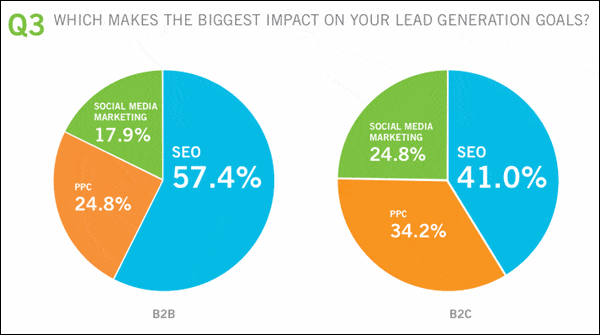Pulling in quality leads is no walk in the park, especially in a crowded online marketplace. SEO for lead generation cuts through this noise so that your business aligns with a genuinely interested target audience.
Ads might catch the eye, but they often miss the mark. SEO, on the other hand, ensures those landing on your site actively seek what you offer. It's about precision, relevance, and making every click count.
With this guide, you'll grasp how SEO makes a difference in attracting qualified leads. Master the right SEO techniques and you'll see your website rise in search rankings and draw in targeted visitors. Before we move forward, let’s cover what SEO lead generation is and why it’s a game-changer for your business.
What Is SEO Lead Generation?

SEO lead generation is the practice of using SEO strategies to attract more visitors to your website, to turn those visitors into potential customers. Essentially, you're optimizing your website to attract people who are likely interested in what you're offering, be it a product, service, or information.
At its core, SEO lead generation combines 2 powerful digital strategies: Search Engine Optimization (SEO) and lead generation.
SEO focuses on optimizing content to rank higher on search engines like Google so it reaches its desired audience. In contrast, lead generation aims to convert those visitors into prospective customers to capture their interest and details. This process can be seen through 2 main lenses: inbound and outbound leads.
- Inbound Leads:
Driven by the appeal of your content and offers.
Come to you typically through organic search or referrals.
- Outbound Leads:
Generated through proactive outreach.
Methods include advertising or direct emails.
While many see SEO as a mere tool for better website rankings, its true potential shines when combined with lead-generation tactics. By targeting relevant keywords and crafting high-quality SEO content, you draw in visitors who are already interested in your products or services.
This proactive approach means that instead of chasing leads, they are naturally driven into your sales funnel. The result? A seamless and efficient system where your website becomes a magnet for potential clients.
Every click isn’t just a visit but a significant component of your SEO lead generation strategy. In the long run, it not only elevates your online visibility but also ensures a higher return on your digital marketing efforts.
Why Is SEO Important To Grow Your Business?

In the crowded internet world, SEO acts like a spotlight that draws customers straight to your business. It ensures that when potential clients search for products or services you offer, your business is placed at the top to convert visitors into leads effectively. Without SEO, even the most user-friendly website will stay hidden in the overcrowded labyrinth of the internet.
Beyond just visibility, SEO fosters trust and credibility. A top rank on search engines signals that your brand is an authority in its field, which in turn, transforms organic traffic into a steady stream of qualified leads. This perceived trustworthiness can significantly influence purchase decisions.
Plus, SEO offers a sustainable competitive edge. Unlike paid ads, which disappear once the budget runs out, a well-optimized site can keep its position and continue to attract organic traffic over time. This consistent inflow of potential clients, with relatively lower upfront costs, positions SEO as a foundational strategy for long-term leads.
A real-life case study will illustrate the practical impact of SEO on your business. Let's delve into a classic example: Airbnb.
Airbnb & SEO’s Power

When Airbnb first started, they weren't the first online home rental service. However, they recognized SEO’s importance early on and integrated it into their growth strategy.
- Localized SEO: As Airbnb expanded globally, they made sure that listings were optimized for local searches. So, if someone in Paris typed "apartment rentals in Paris" in French, Airbnb listings from Paris would rank high on the search results. Their platform was designed to recognize and cater to region-specific keywords.
- Content creation: Airbnb also started creating city guides. These weren’t just for their users but served a dual purpose: They were rich in local keywords and provided valuable information to travelers hence, they ranked high on search engines.
- User reviews: Airbnb’s emphasis on user reviews wasn’t just for trust-building among the community. Search engines prioritize fresh content and every new review is another fresh content piece that improves each SEO listing.
Over time, this meticulous attention to SEO meant that Airbnb listings began to consistently appear on search results first page, often above older, more established rental platforms. The consistent organic traffic flow boosted by SEO strategies played a huge role in Airbnb's rapid growth and its dominance in the rental market space.
2 Ways to Do Lead Generation Through SEO: Direct Vs. Indirect
Knowing the distinction between direct and indirect methods will help you strategize and allocate resources where they matter most. In the upcoming sections, we'll uncover the nuances of both these methods. As you read, actively consider which approach aligns more with your business goals and audience behavior.
I. Direct Lead Generation Through SEO
When we talk about direct lead generation, we talk about approaches that immediately drive potential clients to make an action on your site. The most straightforward way is through selective keyword targets for buyer intent.
Pinpointing and ranking for keywords that exhibit clear purchase intent, like "order custom shoes" or "best software for graphic designers," helps you attract users who are closer to purchasing.
It’s about using transactional keywords that align with the ready buyer’s mindset. These are terms that people use when they've moved beyond the research phase and are ready to take action.

Next, consider optimized landing pages. SEO isn’t just about attracting traffic; it's about getting the right traffic. When you tailor landing pages to resonate with specific audiences and their search intents, you essentially lay out a red carpet for potential leads. This makes it more likely that they'll engage with your call to action.
Consider the difference between an optimized and unoptimized form below:

For businesses that operate within specific areas, local SEO becomes invaluable. It’s about more than just showing up on a map. When someone searches for services "near me" or specifies a city or neighborhood, and you appear at the top, that direct visibility can translate into foot traffic for brick-and-mortar businesses or local online queries.
In today’s digital age, ensuring mobile optimization is another direct avenue. A site that loads seamlessly and offers an intuitive user experience on mobile devices isn’t just a nice-to-have—it’s essential. With the many searches done on mobile, a direct lead often hinges on the mobile user experience. Furthermore, if you're starting a lead generation business, the first step is always to define your expertise, identify your target audience, and create appealing marketing strategies. You may simply acquire leads and convert them into paying customers by designing a user-friendly and informative website, including compelling calls-to-action, and optimizing your site for search engines.
II. Indirect Lead Generation Through SEO
Indirect methods might not provide an immediate conversion, but they plant seeds that can yield results over time. This allows your lead generation to compound instead of paying per lead for your lead generation. Central to this is high-quality content marketing. Regular content that offers genuine value does more than just rank well; it establishes your brand as a reliable voice in your industry. This trust can nudge readers to form genuine leads over time.
One way is using an internal linking strategy. Your site acts as a web. A visitor who lands on one page should find paths to other relevant content that subtly guides them through a journey.
They might have arrived for a specific information piece, but a strategically placed link should ideally lead them to a service or product page, which could indirectly nudge them towards conversion.
Here’s an excellent internal link example. Still, be wary as broken links can harm your SEO efforts and increase bounce rates.

Diversifying content via multimedia engagement is another indirect tactic. Videos or infographics can captivate a visitor's attention differently than text. While they might land on your page for a video tutorial, they might stay for a related article or product link. Over time they familiarize themselves with your brand.
Lastly, while not a traditional SEO element, strengthen your social media posts and overall presence. A robust social media presence indirectly boosts your site's authority and visibility. As your brand's voice and reputation grow on platforms like Twitter, LinkedIn, or Instagram, this goodwill indirectly influences your SEO stature and potential to draw in leads.
With so many different approaches, how do you choose the most ideal one? More importantly, which methods stand out for pulling in top-tier leads? Let’s find out.
10 Best SEO Lead Generation Techniques To Grow Your Business
1. Long-Tail Keyword Optimization

Long-tail keywords are often like hidden gems in the vast keyword spectrum. While shorter, more generic keywords might get a lion’s search volume share, it's the long-tail keywords that have a higher conversion rate.
Take, for instance, the difference between searching for "hotels" versus "luxury hotels in Paris with rooftop pools." While the former is broad and can cater to a large audience, the latter targets a specific audience who knows precisely what they want.
These detailed search queries help business owners, especially niche ones like luxury hotels, to cater to their target audience effectively. By not drawing in casual browsers, they can attract potential customers who have a clear search intent and are actively seeking a unique experience that matches their tastes and preferences.
However, long-tail keyword optimization isn’t just about sprinkling these phrases throughout your content. You have to understand your audience’s intent and trends. Using keyword research tools is an effective marketing strategy to find and target these phrases.
Constant research, monitoring, and tweaking your content to align with these specific queries will elevate your site’s relevance and authority over time.
2. Featured Snippet Targeting
The SEO realm evolved to be more than just ranking first; it's about standing out. Featured snippets, often dubbed as "position zero," give a distinct visibility advantage by placing selected information at the top of search results. They provide quick answers to user queries and offer a snapshot of your content before users click on it.
You can land this coveted spot with a 2-pronged approach:
- Understand common questions within your niche.
- Craft content that succinctly answers them. For instance, a platform that specializes in trading communities might craft an article like "What are the best trading discord communities?" to claim that prime position.

These snippets instantly establish authority. This strategy directly benefits the sales team, as a higher search engine ranking can result in more high-quality leads.
When you attract potential customers through your SEO strategies, retaining them becomes the next challenge. Implementing exit intent popups is a smart way to capture leads just as they're about to leave your site, thus increasing your conversion chances.
3. Voice Search Optimization
Smart assistants like Alexa, Siri, and Google Assistant brought in a new search era: voice search. It’s more personal and immediate and speaks to the user's behavior. But, unlike traditional search, voice search is conversational and demands a different optimization strategy.

To cater to this auditory search mode, your content should be natural and question-based. Traditional keyword stuffing won't cut it. Instead, your content should address queries like, "What's the best method to clean leather shoes?" or "Find me a gluten-free pizza place nearby."
Local businesses, in particular, can immensely benefit from voice search optimization. Consider a local diner in Chicago. If they optimize for voice search, they can capture queries like, "Where's the nearest diner that serves breakfast all day?" Thus, bridging the gap between local businesses and potential customers, voice search optimization is no longer just an option; it's a necessity.
4. Schema Markup Implementation
In the SEO world, context is king. Search engines constantly strive to provide the most relevant content to users, and schema markup aids in this mission by offering additional context about a page’s content. Essentially, it's like giving search engines a more in-depth content summary.
For businesses, schema markup significantly enhances visibility. Let's consider a local theater. Using schema, they can highlight showtimes, ticket prices, and even star ratings from reviews. This not only offers a richer search result but also boosts the user’s clicking chances because of additional information.
Using schema markup effectively also increases your website's credibility. It can drive qualified traffic to your website because it answers the target customer’s search intent more clearly. e
When users see enhanced results – like a recipe with star ratings, cooking time, and calorie count – they're more likely to view your site as a trusted and valuable resource.
5. Video SEO
The digital space witnessed video content’s rise. With platforms like YouTube that are central to many users' online experiences, optimized video content is a must. But unlike written content, videos require a unique SEO approach.
To effectively launch your video SEO, start with thorough research. Use lead generation tools like TubeBuddy or keyword tool for YouTube tailored for video content to gain an edge. Pinpoint the right keywords and weave them seamlessly into video titles, descriptions, and tags to reach your target audience.
Think about a gardening channel that creates a video on "beginner-friendly indoor plants." Proper optimization can lead this video to pop up in search results and get it in front of budding gardeners.
Moreover, don't underestimate a compelling thumbnail. Alongside your optimized title and description, an engaging thumbnail can be the difference between a user who clicks on your video or scrolls past. Combining great video content with robust SEO practices will ensure that your content marketing reaches its target audience and ultimately grows your influence in the digital arena.
6. Link Building With Quality In Mind
The internet’s essence lies in its interconnected nature, and link-building taps into this foundational aspect. But the world moved past the quantity-over-quality approach. In today's digital realm, the quality of your backlinks can make or break your SEO strategy.
To build valuable backlinks, start to foster genuine industry relationships. Collaborations, guest posts, and genuine partnerships with reputable sites offer high-quality backlinks that search engines love. Imagine a new tech gadget reviewed on a renowned tech blog; the backlink to the product site drives traffic and significantly boosts the product site's authority.
However, this process requires vigilance. Conduct regular audits on your backlink profile so that you're not linked to spammy or harmful sites. By using high-quality links to care for your website's online image, you’ll ensure a consistent rise in search results and in turn, your stand in the industry.
7. Content Refresh & Update
Stale content doesn’t just bore your readers; it's also unappealing to search engines. The digital ecosystem thrives on up-to-date information, so often, revisit your older content to breathe new life into your website.
Consider the pace at which large industries like logistics evolve; a piece on Just-In-Time logistics from a year ago could be refreshed with insights from more recent practices. t Similarly, a blog post about "Top Tech Trends" might need to be updated every few months as new technologies emerge and market dynamics change.
But beyond just updating articles or blogs, for platforms that rely heavily on real-time data or frequently changing inventories, the challenge is even greater. Think of eCommerce websites, news platforms, or event-driven sites.
They require a system that not only updates the front-end content but also ensures that the underlying data is synced in real time. Especially for websites powered by databases like MongoDB, it's not just about refreshing an article; it's about ensuring that the data driving that content is current and synchronized.
For such websites using MongoDB, you can utilize tools like MongoDB Change Data Capture. Essentially, these tools ensure real-time content synchronization that gives visitors and search engines the most up-to-date information.
This approach doesn't just elevate the user experience; it also positions your site positively in SEO rankings by consistently refreshed content.
When you refresh content, you don’t just update facts; you also make sure to improve its SEO potency. Incorporating new keywords, optimizing images, and adding relevant internal links can amplify its reach. Let's say a bakery posted a recipe for "gluten-free cookies" a while back.
When they revisit it, they can incorporate new techniques or ingredients that became popular so their audience gets the latest and best information.
Moreover, updated content sends positive signals to search engines. It shows that you aim to provide relevant and current information to your audience. Think about it: If you were to research "best smartphones," would you trust a list from 2019 or 2023? By keeping your content fresh, you position your brand as a reliable and up-to-date information source.
8. Mobile-First Indexing Optimization
With so many users accessing websites via mobile devices, search engines transitioned to a mobile-first indexing system. This means that your mobile’s website version becomes the primary version that search engines index.

Think about an online fashion boutique. While their desktop website might offer an immersive experience with high-resolution images and interactive features, the mobile version needs to be slick, fast, and user-friendly. This is where potential shoppers might look up "summer dresses" while on the go or quickly check product reviews between lunch breaks.
This shift underscores on-page optimization, fast-load pages, and easy navigation’s importance on mobile platforms. Brands that overlook mobile optimization risk not only a drop in search engine rankings but also miss out on a substantial portion of their audience who primarily browse and shop via their phones.
9. Content Clustering
As search engines evolve, they've become better at understanding content contextually rather than focusing on keywords. Content clustering, or topic clusters, is an approach where a "pillar" page acts as the main hub for a specific topic, and multiple related "cluster" pages link back to it. This creates a thematic structure that search engines favor.

Let’s consider a website centered around pet care. Their pillar page might delve deep into comprehensive dog training techniques. Clustered around, it could be related articles, from basic training commands to more specialized niches like dog boot camps or agility training.
But why does this work? Clustering content around target keywords lets search engines see the interconnected nature of your content and deem it more reliable and authoritative. It’s a strategic way to tell search engines, “Hey, we know our stuff,” and, at the same time, provide valuable, interconnected content for your audience.
10. User Experience (UX) & Core Web Vitals
Google has always reiterated that user experience is the heart’s ranking system, and with the introduction of core web vitals, this focus has only intensified. These vitals include metrics related to speed, responsiveness, and visual stability that aim to help you measure user experience on the web.
Imagine users navigating a site to read about "best hiking trails in Colorado." If the site takes too long to load or if there are unexpected layout shifts, readers are likely to bounce off and seek information elsewhere. This is precisely what Google aims to prevent by prioritizing sites that offer a stellar UX.
To ace these vitals, you need to ensure that your sites load quickly, remain stable as users scroll, and respond instantly to user interactions. You don’t have just to appease search engines but also offer users a seamless digital experience so that they stay longer and engage more with the content.
Conclusion
SEO for lead generation isn't just a trend; it's a key marketing strategy if you want genuine engagement online. By optimizing for search engines, you can attract the right audience. This isn't about mere visibility but meaningful interactions.
Remember to refresh your content regularly. The SEO world is dynamic, so stay up-to-date with the latest strategies and trends. Don’t forget to choose quality over quantity too. This applies to content, backlinks, keywords, and all SEO facets. High-quality inputs boost your online authority and trustworthiness.
If you're on the lookout to enhance your outreach efforts further, consider Linkio. With our automated anchor text suggestions, Linkio is more than just an SEO tool. It's a powerful cold outreach software designed to streamline and automate your prospects and outreach endeavors.
In just the past week, over 153 individuals and businesses have started their free trial. Don’t be left behind; see how we can elevate your outreach strategy. Start your free trial today.
Author Bio

Burkhard Berger is the founder of Novum™. He helps innovative B2B companies implement revenue-driven SEO strategies to scale their organic traffic to 1,000,000+ visitors per month. Curious about what your true traffic potential is?




























